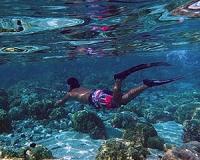 |
Santa Fe NM (SPX) Mar 23, 2011 Garbage mounds left by prehistoric humans might have driven the formation of many of the Florida Everglades' tree islands, distinctive havens of exceptional ecological richness in the sprawling marsh that are threatened by human development. Tree islands are patches of relatively high and dry ground that dot the marshes of the Everglades. Typically a meter (3.3 feet) or so high, many of them are elevated enough to allow trees to grow. They provide a nesting site for alligators and a refuge for birds, panthers, and other wildlife. Scientists have thought for many years that the so-called fixed tree islands (a larger type of tree island frequently found in the Everglades' main channel, Shark River Slough) developed on protrusions from the rocky layer of a mineral called carbonate that sits beneath the marsh. Now, new research indicates that the real trigger for island development might have been middens, or trash piles left behind from human settlements that date to about 5,000 years ago. These middens, a mixture of bones, food discards, charcoal, and human artifacts (such as clay pots and shell tools), would have provided an elevated area, drier than the surrounding marsh, allowing trees and other vegetation to grow. Bones also leaked phosphorus, a nutrient for plants that is otherwise scarce in the Everglades. "This goes to show that human disturbance in the environment doesn't always have a negative consequence," says Gail Chmura, a paleoecologist at McGill University in Montreal, Canada, and one of the authors of the study. Chmura will be presenting her research tomorrow, Tuesday 22 March, at the American Geophysical Union's Chapman Conference on Climates, Past Landscapes, and Civilizations. About 95 scientists have converged on Santa Fe this week to discuss the latest research findings from archeology, paleoclimatology, paleoecology, and other fields that reveal how changes in regional and global climate have impacted the development and fates of societies. In a previous scientific investigation of tree islands, Margo Schwadron, an archeologist with the National Park Service, cut through the elevated bedrock at the base of two islands and discovered that it was actually a so-called "perched carbonate layer," because there was more soil and a midden below. Later, a team including Chmura's graduate student Maria-Theresia Graf performed additional excavations in South Florida and found more of the perched carbonate layers. Chemical analysis of samples of these curious perched layers revealed that they are made up partially of carbonates that had dissolved from the bedrock below, Chmura says. The layer also contains phosphorus from dissolved bones, she adds. Her team concluded that trees are key to the formation of this layer: During South Florida's dry season, their roots draw in large quantities of ground water but allow the phosphates and carbonates dissolved in it to seep out and coalesce into the stone-like layer. The perched carbonate plays a key role in letting tree islands rebound after fires: because it does not burn, it protects the underlying soil, and it maintains the islands' elevation, allowing vegetation to regrow after the fire. Humans are now threatening the existence of tree islands, by cutting down trees (whose roots keep the perched layer in place) and artificially maintaining high water levels year-round in some water control systems, which could cause the layer to dissolve. Chmura's team now wants to explore exactly when trees started growing on the tree islands.
Share This Article With Planet Earth
Related Links McGill University Water News - Science, Technology and Politics
 Fish Know To Avoid The Spear
Fish Know To Avoid The SpearBrisbane, Australia (SPX) Mar 23, 2011 Fish are not as dumb as people sometimes think: marine scientists have found that fish that are regularly hunted with spearguns are much more wary and keep their distance from fishers. In investigating the effects of marine areas closed to fishing by customary laws, an international team of researchers working in the Pacific found that fish exposed to speargun fishing take flight much earl ... read more |
|
| The content herein, unless otherwise known to be public domain, are Copyright 1995-2010 - SpaceDaily. AFP and UPI Wire Stories are copyright Agence France-Presse and United Press International. ESA Portal Reports are copyright European Space Agency. All NASA sourced material is public domain. Additional copyrights may apply in whole or part to other bona fide parties. Advertising does not imply endorsement,agreement or approval of any opinions, statements or information provided by SpaceDaily on any Web page published or hosted by SpaceDaily. Privacy Statement |